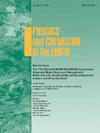Study on the temperature field in coal-rock mass and the temporal and spatial evolution of overburden damage in the tar-rich coal pyrolysis zone
IF 4.1
3区 地球科学
Q2 GEOSCIENCES, MULTIDISCIPLINARY
引用次数: 0
Abstract
Tar-rich coal is a type of coal resource that produces oil and gas through low-temperature pyrolysis. In-situ pyrolysis is crucial for reducing global carbon emissions, protecting the ecological environment, and improving engineering safety and benefits. In this study, a physical simulation test system was constructed for the in-situ pyrolysis of tar-rich coal to monitor the change of formation temperature during tar-rich coal pyrolysis in real time. Furthermore, the fracture development characteristics of overlying strata caused by temperature field changes were analyzed. The results demonstrated that as the heating time increased, the horizontal temperature field of each layer evolved into the high-temperature center. Moreover, the vertical temperature field transitioned from a low temperature in the middle and high temperatures on both sides to a symmetrical distribution of higher temperatures in the middle than on both sides. The fracture development degree was considerably higher in the middle and lower parts of the same stratum. Horizontal and vertical cracks were observed in the middle of the mudstone layer, and the broken rocks were larger. Furthermore, the fracture degree of rock mass on both sides was higher than that in the middle part, with the separation from the rock being relatively smooth.

富焦油煤热解带煤岩体温度场及覆盖层损伤时空演化研究
富焦油煤是一种通过低温热解产生油气的煤资源。就地热解对于减少全球碳排放、保护生态环境、提高工程安全性和效益具有重要意义。本研究构建了富焦油煤原位热解物理模拟试验系统,实时监测富焦油煤热解过程中地层温度的变化。分析了温度场变化对上覆地层裂缝发育的影响。结果表明:随着加热时间的增加,各层的水平温度场向高温中心演化;垂直温度场由中部温度低、两侧温度高转变为中部温度高于两侧温度的对称分布。同一地层中下部裂缝发育程度明显较高。泥岩层中部存在水平和垂直裂缝,破碎岩石较大。两侧岩体的断裂程度高于中部,与岩体的分离相对平稳。
本文章由计算机程序翻译,如有差异,请以英文原文为准。
求助全文
约1分钟内获得全文
求助全文
来源期刊

Physics and Chemistry of the Earth
地学-地球科学综合
CiteScore
5.40
自引率
2.70%
发文量
176
审稿时长
31.6 weeks
期刊介绍:
Physics and Chemistry of the Earth is an international interdisciplinary journal for the rapid publication of collections of refereed communications in separate thematic issues, either stemming from scientific meetings, or, especially compiled for the occasion. There is no restriction on the length of articles published in the journal. Physics and Chemistry of the Earth incorporates the separate Parts A, B and C which existed until the end of 2001.
Please note: the Editors are unable to consider submissions that are not invited or linked to a thematic issue. Please do not submit unsolicited papers.
The journal covers the following subject areas:
-Solid Earth and Geodesy:
(geology, geochemistry, tectonophysics, seismology, volcanology, palaeomagnetism and rock magnetism, electromagnetism and potential fields, marine and environmental geosciences as well as geodesy).
-Hydrology, Oceans and Atmosphere:
(hydrology and water resources research, engineering and management, oceanography and oceanic chemistry, shelf, sea, lake and river sciences, meteorology and atmospheric sciences incl. chemistry as well as climatology and glaciology).
-Solar-Terrestrial and Planetary Science:
(solar, heliospheric and solar-planetary sciences, geology, geophysics and atmospheric sciences of planets, satellites and small bodies as well as cosmochemistry and exobiology).
 求助内容:
求助内容: 应助结果提醒方式:
应助结果提醒方式:


